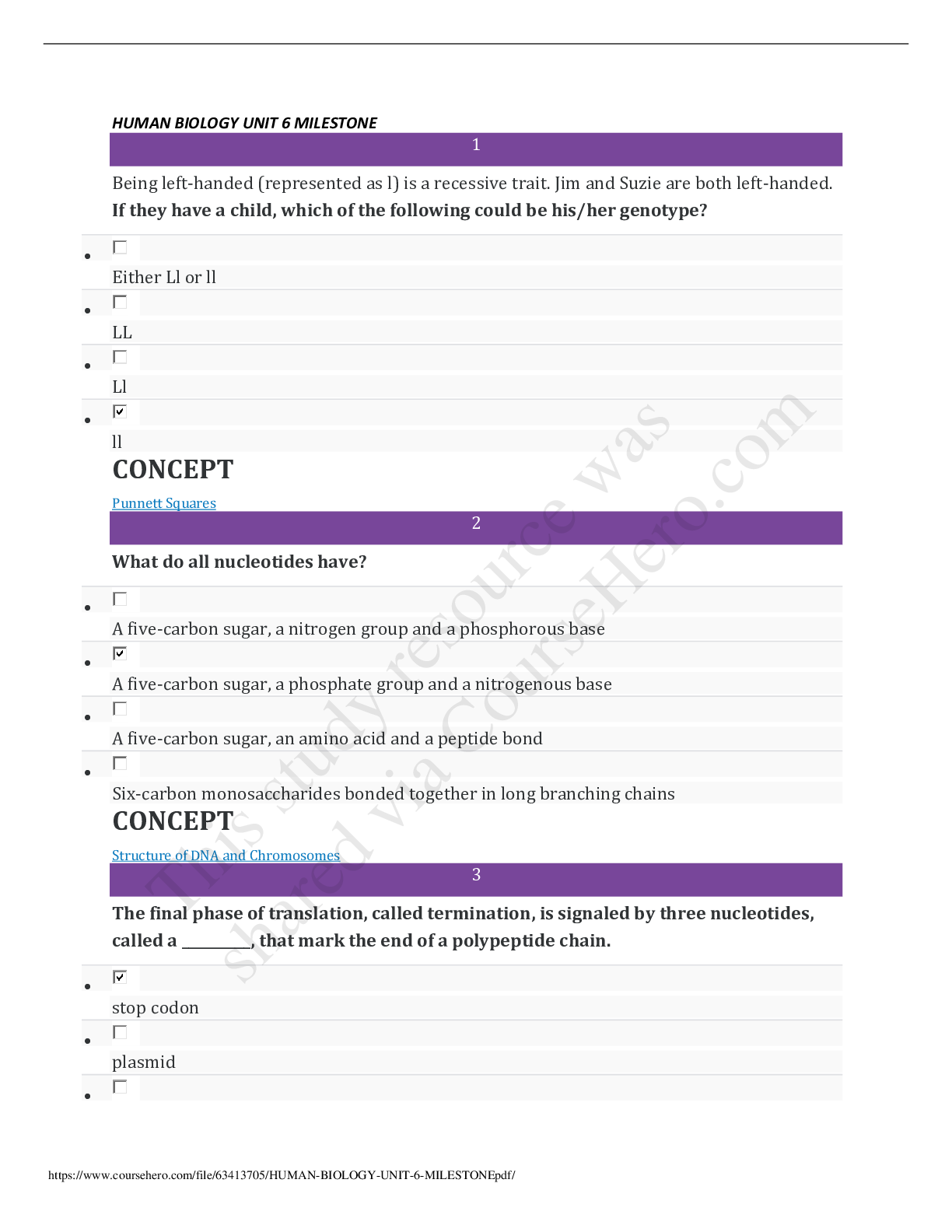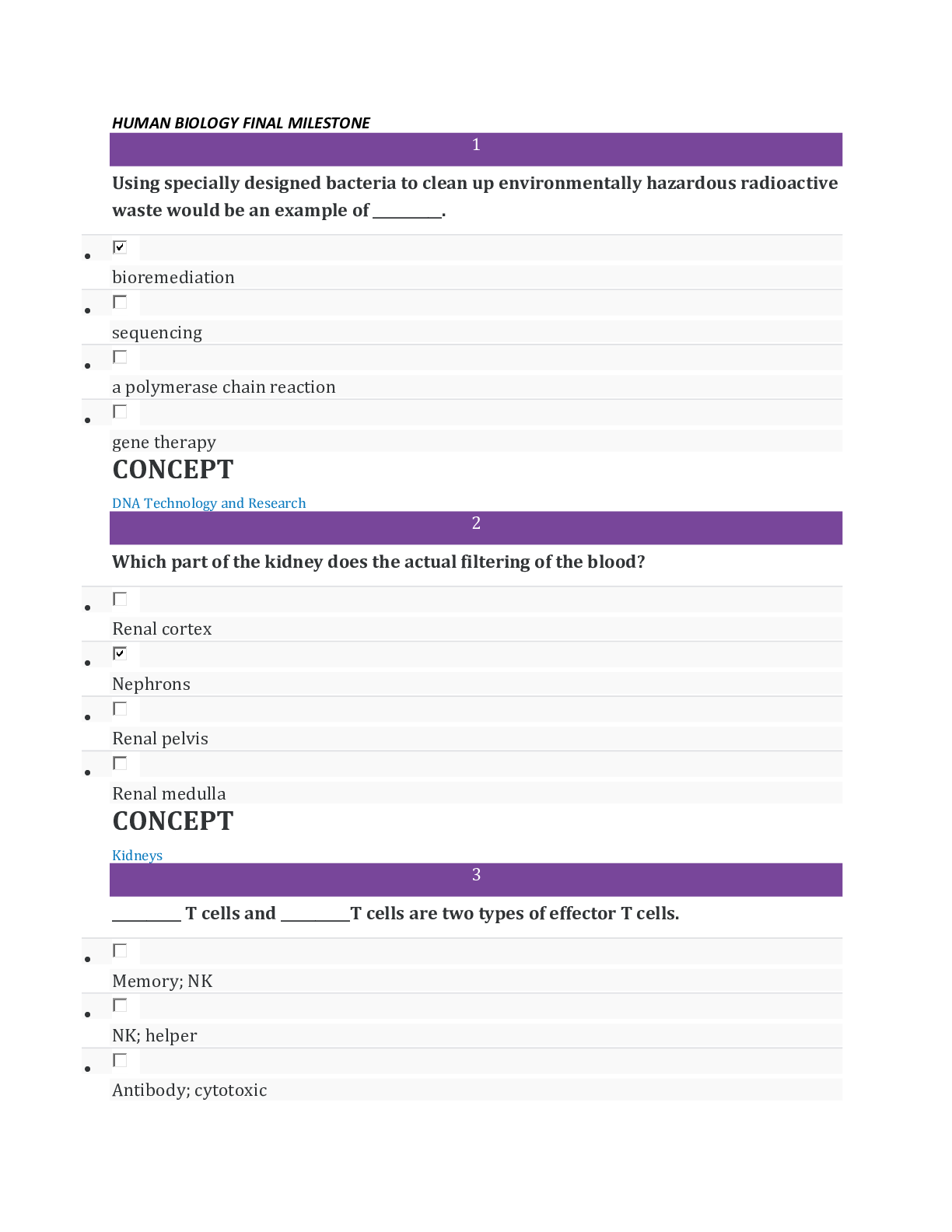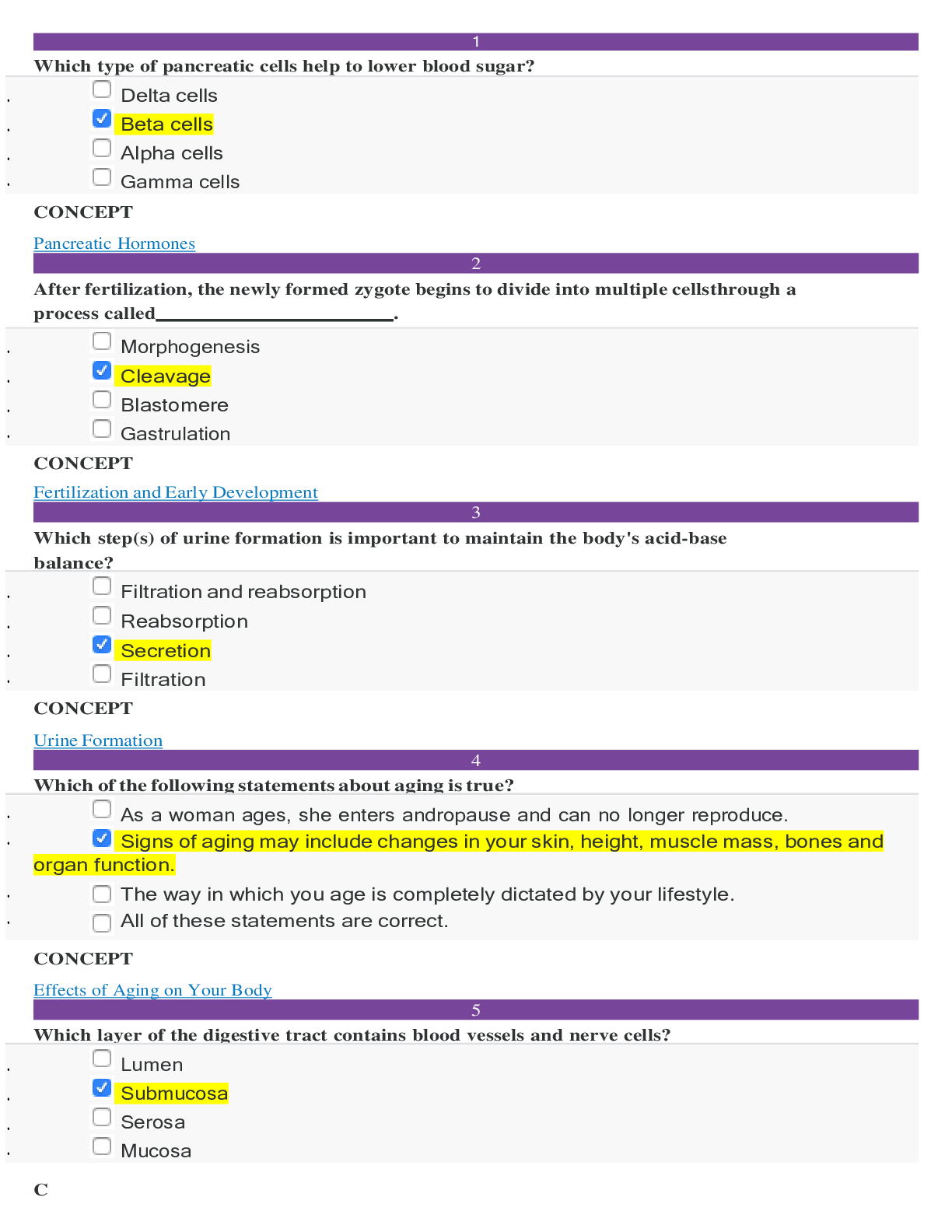Biology > SOPHIA PATHWAY > SOPHIA_Unit_5_Tutorials_Endocrine_Reproductive_Digestive_Urinary_Systems 2020 - Southern New Hampshi (All)
SOPHIA_Unit_5_Tutorials_Endocrine_Reproductive_Digestive_Urinary_Systems 2020 - Southern New Hampshire University | SOPHIA_Unit_5_Tutorials_Endocrine_Reproductive_Digestive_Urinary_Systems 2020
Document Content and Description Below
SOPHIA_Unit_5_Tutorials_Endocrine_Reproductive_Digestive_Urinary_Systems 2020 - Southern New Hampshire University Unit 5 Tutorials: Endocrine, Reproductive, Digestive & Urinary systems INSIDE UNIT ... 5 The Endocrine System Endocrine System Organs of the Endocrine System Steroid and Non-Steroid Hormones Adrenal Glands Blood Sugar Disorders Thyroid and Parathyroid Pancreatic Hormones Hypothalamus and Pituitary Gland The Reproductive System Female Reproductive System Ovarian Cycle and Menstrual Cycle Male Reproductive System Sperm Formation STDs Effects of Aging on Your Body Prenatal Development Fertilization and Early Development Implantation Placenta Embryonic and Fetal Development Labor and Birth Developmental Disorders The Digestive System Digestion The Alimentary Canal Chewing and Swallowing Stomach Small Intestine Pancreas, Gallbladder, & Liver Large Intestine Digestive System Disorders © 2019 SOPHIA Learning, LLC. SOPHIA is a registered trademark of SOPHIA Learning, LLC. Page 1Nutrition and Health The Urinary System Urinary System Kidneys Urine Formation Fluid Balance and Blood Pressure Blood pH Kidney Health Endocrine System by Sophia Tutorial WHAT'S COVERED Welcome to this lesson on the endocrine system and hormones. Today you will be learning about what the endocrine system is, and how hormones can interact within the endocrine system. Specifically, you will look at: 1. Endocrine System Overview 2. Opposing Hormone Interaction 3. Synergistic Hormone Interaction 4. Permissive Hormone Interaction 1. Endocrine System Overview The endocrine system is a body system that consists ofglands. Glands are clusters of cells that produce and secrete specific molecules such as hormones. Hormones are small signaling molecules (derived from either amino acids or lipids) that interact with target cells to change those cells' behavior in a way that promotes homeostasis. Many hormones play specific roles in specific parts of the body. Certain cells have a specific receptor for a particular type of hormone, ensuring that hormone can only affect those target cells. Because of this, not all cells are affected by all hormones. TERMS TO KNOW Endocrine System A system of glands that produces and secretes hormones into the bloodstream; the endocrine system is used to communicate on a broad scale to the cells in the body Glands Glands are clusters of cells that produce and secrete specific molecules; endocrine glands secrete hormones directly into the bloodstream, where they can quickly reach their target cells anywhere in the body Hormones The major chemical messenger of the endocrine system, hormones, are produced, stored and secreted by glands; hormones either increase or decrease activity of the cells with which they interact Target Cell The cell or group of cells with which a hormone is designed to interact © 2019 SOPHIA Learning, LLC. SOPHIA is a registered trademark of SOPHIA Learning, LLC. Page 22. Opposing Hormone Interaction Hormones can actually interact with each other in order to produce different effects. One type of hormone interaction is an opposing interaction; where the effect of one hormone opposes the effect of another. EXAMPLE Examples of opposing hormone interactions are insulin and glucagon. Insulin is a type of hormone that helps to lower sugar levels, while glucagon is a type of hormone that helps to increase blood sugar levels. There are certain situations when these hormones need to be released, such as after a meal (insulin) or when starved (glucagon), but not at the same time. TERM TO KNOW Opposing Interaction A term used to describe hormones that create opposite effects of one another; an example would be that insulin lowers blood glucose while glucagon elevates blood glucose 3. Synergistic Hormone Interaction Sometimes hormones can create synergistic interactions, which means the two hormones cooperate with each other to affect a target cell. TERM TO KNOW Synergistic Interaction A term used to describe hormones that create similar effects through slightly different mechanisms; an example would be that ADH stimulating kidneys retain water while aldosterone stimulates kidneys to retain sodium, which in turn retains water 4. Permissive Hormone Interaction A permissive interaction is when one hormone will prepare a cell for another hormone. For the second hormone to be able to affect the target cell, the target cell first has to be exposed to the first hormone. Think of it as one hormone will prep the cell for the other hormone to be able to take effect. The second hormone does not take effect until the cell has been exposed to the first hormone. TERM TO KNOW Permissive Interaction When one hormone allows another hormone to have its full effect; an example would be thyroid hormones allowing growth hormone to have its full metabolic effects SUMMARY This lesson has been a brief overview of the endocrine system and hormone interactions. Specifically, you looked at opposing, synergistic, and permissive hormone interactions. Keep up the learning and have a great day! Source: THIS WORK IS ADAPTED FROM SOPHIA AUTHOR AMANDA SODERLIND TERMS TO KNOW © 2019 SOPHIA Learning, LLC. SOPHIA is a registered trademark of SOPHIA Learning, LLC. Page 3Endocrine System A system of glands that produces and secretes hormones into the bloodstream; the endocrine system is used to communicate on a broad scale to the cells in the body. Gland Glands are clusters of cells that produce and secrete specific molecules. Endocrine glands secrete hormones directly into the bloodstream, where they can quickly reach their target cells anywhere in the body. Hormones The major chemical messenger (derived from either amino acids or lipids) of the endocrine system. Hormones are produced, stored and secreted by glands; hormones either increase or decrease activity of the cells with which they interact. Opposing Interaction A term used to describe hormones that create opposite effects of one another. An example would be: insulin lowers blood glucose while glucagon elevates blood glucose. Permissive Interaction When one hormone allows another hormone to have its full effect. An example would be: thyroid hormones allowing growth hormone to have its full metabolic effects. Synergistic Interaction A term used to describe hormones that create similar effects through slightly different mechanisms. An example would be: ADH stimulating kidneys to retain water while aldosterone stimulates kidneys to retain sodium, which in turn retains water. Target Cell The cell or group of cells with which a hormone is designed to interact. © 2019 SOPHIA Learning, LLC. SOPHIA is a registered trademark of SOPHIA Learning, LLC. Page 4Organs of the Endocrine System by Sophia Tutorial WHAT'S COVERED Welcome to this lesson on organs of the endocrine system. Today you are going to be looking at a brief overview of the various organs and the hormones they secrete that are all associated with the endocrine system. Specifically, you will learn about: 1. Overview 2. Hypothalamus 3. Pituitary Gland 4. Pineal Gland 5. Thyroid & Parathyroid Glands 6. Thymus Gland 7. Pancreas 8. Adrenal Glands 9. Ovaries & Testes 1. Overview Below is a diagram of the various organs of the endocrine system and the hormones that they secrete. 2. Hypothalamus The hypothalamus produces hormones such as ADH and oxytocin. ADH is also known as the antidiuretic hormone and helps to regulate urination. Oxytocin is a hormone that plays a role in childbirth, among other things. TERM TO KNOW Hypothalamus © 2019 SOPHIA Learning, LLC. SOPHIA is a registered trademark of SOPHIA Learning, LLC. Page 5The hypothalamus is at the "basement" of the forebrain, between the cerebrum and the midbrain/brainstem; the hypothalamus controls the activity of the pituitary gland. 3. Pituitary Gland The pituitary gland is a gland that works very closely with the hypothalamus. The pituitary gland stores and releases hormones that were produced in the hypothalamus. In addition, the pituitary gland also makes and secretes some of its own hormones, like growth hormone. TERM TO KNOW Pituitary Gland Called the “master gland” because of its effects on other glands; the endocrine hormones increase activity/secretion of many major glands of the endocrine system. 4. Pineal Gland Another part of the endocrine system that we'll discuss is thepineal gland. The pineal gland is a gland that secretes melatonin, which is a hormone that plays a role in our sleep and wake cycles. TERM TO KNOW Pineal Gland A gland located in the cerebrum that secretes melatonin, an important hormone for regulating sleep/wake cycles. 5. Thyroid & Parathyroid Glands The thyroid gland is located in front of the trachea (in men, it is just below the Adam's apple), and has a couple of different roles. The thyroid gland releases two main hormones: Thyroid hormone, abbreviated TH, which plays a role in metabolism and calcitonin, which is a hormone that plays a role in bone remodeling and blood calcium levels. Parathyroid glands are four tiny glands found on the thyroid gland and also play a role in bone remodeling. TERMS TO KNOW Thyroid Gland The largest endocrine gland located on the anterior trachea, the thyroid gland secretes hormones that regulate metabolism; the thyroid gland also secretes a hormone called calcitonin that lowers blood calcium levels by increasing the kidneys' excretion of calcium and inhibiting osteoclasts. Parathyroid Glands A group of glands on the posterior thyroid that secrete parathyroid hormones to increase blood calcium levels by decreasing the kidneys' excretion of calcium and increasing osteoclast activity. 6. Thymus Gland The thymus gland releases thymosins; it is also where T cells mature, which are a part of our immune system. TERM TO KNOW Thymus Gland A gland located above the heart; it secretes thymosins, which mature the immune system's T cells. © 2019 SOPHIA Learning, LLC. SOPHIA is a registered trademark of SOPHIA Learning, LLC. Page 67. Pancreas The role of the pancreas is to make and secrete insulin and glucagon. Insulin is a hormone that lowers blood sugar levels, and glucagon is a hormone that raises blood sugar levels. Somebody who has diabetes doesn't create or secrete the hormone insulin. Because of this, they have to take insulin injections to help lower blood sugar levels in their body. TERM TO KNOW Pancreas The endocrine functions of the pancreas are to secrete insulin and glucagon to regulate blood glucose levels. 8. Adrenal Glands The two adrenal glands, found on top of the kidneys, are the next glands of the endocrine system we're going to talk about. Adrenal glands basically secrete the hormones epinephrine and norepinephrine, which create the fight or flight response that prepares the body for different types of stress. IN CONTEXT If you're in a dangerous situation, you get a rush of adrenaline. That feeling is coming from hormones the adrenal gland is releasing. It also sends out cortisol and aldosterone in response to stress. TERM TO KNOW Adrenal Glands Located on top of the kidneys, the adrenal glands have two anatomic divisions: The adrenal cortex and the adrenal medulla. The adrenal cortex secretes hormones that regulate body mineral levels and metabolism and also aids in the production of sex hormones. The adrenal medulla releases hormones called catecholamines (adrenaline) that elevate our metabolism in response to stress. 9. Ovaries & Testes The female-specific organs of the endocrine system are theovaries. The ovaries release progesterone and estrogen, which are involved in the menstrual cycle and pregnancy, among other things. The male-specific organs of the endocrine system are the testes. The testes make and secrete testosterone, which is involved in the production of sperm, among other things. TERMS TO KNOW Ovaries The primary sex organs of females and the primary source of estrogen and progesterone; the ovaries are also where the eggs are matured and released. Testes The primary sex organs of males and are the primary source of testosterone; the testes are also where sperm is produced and matured. SUMMARY This lesson has been an overview of the various glands of the endocrine system, as well as the different hormones that those organs create and secrete. Specifically, you learned about the © 2019 SOPHIA Learning, LLC. SOPHIA is a registered trademark of SOPHIA Learning, LLC. Page 7hypothalamus, pituitary gland, pineal gland, the thyroid and parathyroid glands, thymus gland, pancreas, adrenal glands, and the ovaries and testes. Keep up the learning and have a great day! Source: THIS WORK IS ADAPTED FROM SOPHIA AUTHOR AMANDA SODERLIND ATTRIBUTIONS Endocrine System | Author: Wikipeda | License: Public Domain TERMS TO KNOW Adrenal Glands Located on top of the kidneys, the adrenal glands have two anatomic divisions: The adrenal cortex and the adrenal medulla. The adrenal cortex secretes hormones that regulate body mineral levels and metabolism and also aids in the production of sex hormones. The adrenal medulla releases hormones called catecholamines (adrenaline) that elevate our metabolism in response to stress. Hypothalamus The hypothalamus is at the "basement" of the forebrain, between the cerebrum and the midbrain/brainstem. The hypothalamus controls that activity of the pituitary gland. Ovaries Ovaries are the primary sex organs of females; they are females' primary source of the hormones estrogen and progesterone. The ovaries are also where the eggs are matured and released. Pancreas The endocrine functions of the pancreas are to secrete insulin and glucagon to regulate blood glucose levels. Parathyroid Glands A group of glands on the posterior thyroid that secrete parathyroid hormone to increase blood calcium levels by decreasing renal excretion of calcium and increasing osteoclast activity. Pineal Gland A gland located in the cerebrum that secretes melatonin, an important hormone for regulating sleep/wake cycles. Pituitary Gland Called the “master gland” because of its effects on other glands; endocrine hormones increase activity/secretion of many major glands of the endocrine system. Testes Testes are the primary sex organs of males, and are their primary source of testosterone. The testes are also where the sperm is produced and matured. © 2019 SOPHIA Learning, LLC. SOPHIA is a registered trademark of SOPHIA Learning, LLC. Page 8Thymus Gland A gland located above the heart. It secretes thymosins, which mature the immune system's T-cells. Thyroid Gland Located on the anterior trachea, the thyroid gland secretes hormones that regulate metabolism. The thyroid gland also secretes a hormone called calcitonin that lowers blood calcium levels by increasing the kidneys' excretion of calcium into the urine and inhibiting osteoclasts. © 2019 SOPHIA Learning, LLC. SOPHIA is a registered trademark of SOPHIA Learning, LLC. Page 9Steroid and Non-Steroid Hormones by Sophia Tutorial WHAT'S COVERED Welcome to this lesson on steroid and non-steroid hormones. In this lesson you will look at: 1. Hormone Overview 2. Steroid Hormones 3. Non-Steroid Hormones 4. Secondary Messenger 1. Hormone Overview Hormones are chemical messengers (derived from either amino acids or lipids) of the endocrine system. They are made and secreted by glands. Once secreted, hormones interact with specific types of cells, signaling the cell's activity to change in some way. Cell receptors are specific to the hormones they interact with, and certain types of hormones can only affect certain types of cells. This means that not every hormone affects every type of cell because not all cells will possess their receptors. 2. Steroid Hormones Steroid hormones are lipids that are made from cholesterol. They're produced in the adrenal glands and reproductive glands. Because steroid hormones are lipids made from cholesterol, they are non-polar, hydrophobic (water-repelling) molecules. This means they can't move through blood (which is very watery) without help, but they can move through the plasma membrane easily. They get to make a direct path through the cell to receptors on the nucleus. Steroid hormones will bind to receptors on the nucleus, and this will allow them to affect the behavior of the DNA. They can turn genes and DNA on or off; this controls protein-making mechanisms and can directly affect the target cell's function. EXAMPLE Examples of steroid hormones are estrogen (which is involved in female reproduction) and testosterone (which is involved in male reproduction). TERM TO KNOW Steroid Hormones Hormones that have a cholesterol backbone and are not soluble in water due to their lipid structure; steroid hormones are transported through the blood attached to carrier proteins; steroid hormones penetrate the cell membrane and interact with nuclear receptors that affect DNA transcription. 3. Non-Steroid Hormones Non-steroid hormones are derived from amino acids; as a result, they tend to be more polar/hydrophilic (water-attracting). This means that they can pass easily through the blood (which is very watery), but cannot pass through the target cells' plasma membranes. Instead, non-steroid hormones bind to receptors on the target cell's plasma membrane. TERM TO KNOW © 2019 SOPHIA Learning, LLC. SOPHIA is a registered trademark of SOPHIA Learning, LLC. Page 10Non-steroid Hormones A class of hormones that are primarily derived from amino acids and are water soluble due to their polar nature; non-steroid hormones are transported freely through the blood; non-steroid hormones interact with receptors on the cell membrane and activate secondary messenger systems that carry out their effects within the cell. 4. Secondary Messenger Remember, steroid hormones bind to receptors on the nucleus, and non-steroid hormones are going to bind to receptors on the target cell's plasma membrane. Because non-steroid hormones aren't able to pass through the plasma membrane, they will activate what are called secondary messengers. Secondary messengers relay information to the interior of the cell. When non-steroid hormones bind with their receptors on the plasma membrane, the secondary messenger will be activated. The secondary messenger will then relay the signal ultimately to the DNA, where changes in the target cell's behavior are controlled. TERM TO KNOW Secondary Messenger A group of signaling molecules located near a hormone receptor on the inside of the cell; when a non-steroid hormone binds to its receptor, it activates secondary messenger systems that carry out specific effects inside of the cell. Non-steroid hormones rely on secondary messenger signaling molecules because they are unable to penetrate the cell membrane and get into the cell. SUMMARY This lesson has been an overview of hormones, including steroid and non-steroid hormones and secondary messengers. Keep up the learning and have a great day! Source: THIS WORK IS ADAPTED FROM SOPHIA AUTHOR AMANDA SODERLIND TERMS TO KNOW Non-steroid Hormones A class of hormones that are primarily derived from proteins and are water soluble due to their polar nature; non-steroid hormones are transported freely through the blood. Non-steroid hormones interact with receptors on the cell membrane and activate secondary messenger systems that carry out their effects within the cell. Secondary Messenger A group of signaling molecules located near a hormone receptor on the inside of the cell; when a non-steroid hormone binds to its receptor on the extracellular side of the plasma membrane, it activates secondary messenger systems that carry out specific effects inside of the cell. Non-steroid hormones rely on secondary messenger signaling molecules because they are unable to penetrate the cell membrane and get into the cell. Steroid Hormones Hormones that have a cholesterol backbone and are not soluble in water due to their lipid structure; steroid hormones are transported through the blood attached to carrier proteins. Steroid hormones © 2019 SOPHIA Learning, LLC. SOPHIA is a registered trademark of SOPHIA Learning, LLC. Page 11penetrate the cell membrane and interact with nuclear receptors that affect the DNA. © 2019 SOPHIA Learning, LLC. SOPHIA is a registered trademark of SOPHIA Learning, LLC. Page 12Adrenal Glands by Sophia Tutorial WHAT'S COVERED Welcome to this lesson on the adrenal glands. Today you will be looking at the structure and function of the adrenal glands and the role they play in the endocrine system. Specifically, you will learn about: 1. Adrenal Glands Overview 2. Adrenal Glands Structure a. Adrenal Cortex b. Adrenal Medulla 1. Adrenal Glands Overview The adrenal glands are located just above the kidneys. You have two kidneys and, therefore, two adrenal glands. Adrenal glands produce hormones that help regulate various things, such as glucose levels of the blood, blood pressure, and blood circulation. 2. Adrenal Gland Structure The image below is a cross-section of an adrenal gland. The adrenal cortex is the outer part of the adrenal © 2019 SOPHIA Learning, LLC. SOPHIA is a registered trademark of SOPHIA Learning, LLC. Page 13gland, and the adrenal medulla is the inner part. It's important to understand the structure of adrenal glands because each of the parts of the adrenal gland possesses different functions. 2a. Adrenal Cortex The adrenal cortex secretes glucocorticoids and mineralocorticoids. These are two classes of hormones that are secreted by the adrenal cortex. Glucocorticoids help to increase blood glucose levels and also play a role in decreasing inflammation of tissues. Cortisol is a glucocorticoid that stimulates the liver to synthesize glucose, which is a process called gluconeogenesis. Hypoglycemia is a condition in which a person has chronic low blood sugar and sometimes occurs because too little cortisol (a glucocorticoid hormone) is produced. Cortisol also plays a role in inflammation; Cortisone is an over-the-counter drug that you can buy at any drugstore acts like cortisol to reduce inflammation. Mineralocorticoids are the other class of hormones that are produced by the adrenal cortex. Mineralocorticoids help to adjust the concentration of mineral salts, like potassium or sodium, in your extracellular fluids. EXAMPLE An example of a mineralocorticoid is aldosterone, which acts on the kidneys. Aldosterone stimulates sodium reabsorption and therefore, water reabsorption. Aldosterone secretion is triggered by a decrease in blood pressure or blood volume, or a decrease in sodium levels of the blood. TERMS TO KNOW Adrenal Cortex The outer covering of the adrenal gland that secretes hormones that regulate body mineral levels, metabolism, and aid in the production of sex hormones. Glucocorticoids Hormones that affect glucose metabolism of the body, the most abundant one being cortisol, a.k.a. the stress hormone. Gluconeogenesis The process of converting amino acids and lipids into glucose; this process takes place in the liver. Hypoglycemia The clinical term for low blood sugar. Mineralocorticoids Hormones that maintain mineral homeostasis; aldosterone is a hormone that stimulates the kidneys to retain sodium. 2b. Adrenal Medulla The adrenal medulla is the inner part of the adrenal gland. The adrenal medulla produces and secretes epinephrine and norepinephrine. Normally epinephrine and norepinephrine act as neurotransmitters elsewhere in the body, however when they're released by the adrenal medulla, they help to regulate blood circulation. Epinephrine and norepinephrine help to increase heart rate. They also help to dilate and constrict arterioles, © 2019 SOPHIA Learning, LLC. SOPHIA is a registered trademark of SOPHIA Learning, LLC. Page 14along with dilating bronchioles. This allows oxygen to flow to cells that demand more energy when the body is stressed or excited. They're often called stress hormones because they play a big role when the body is in the flight or fight response. TERMS TO KNOW Adrenal Medulla The adrenal medulla releases hormones called catecholamines (adrenaline) that elevate our metabolism in response to stress; the adrenal medulla is controlled by the sympathetic nervous system (SNS). Epinephrine Classified as a catecholamine (adrenaline) and is secreted from the adrenal medulla; epinephrine is found in higher amounts in the blood than its counterpart norepinephrine and has slightly more of an effect on the heart. Norepinephrine Classified as a catecholamine (adrenaline) and is secreted from the adrenal medulla, norepinephrine is found in lower amounts in the blood than its counterpart epinephrine and has slightly more of an effect on the blood vessels. SUMMARY This lesson has been an overview on the structure, function, and role of the adrenal glands in the endocrine system. Specifically, you learned about functions of the adrenal cortex and the adrenal medulla. Keep up the learning and have a great day! Source: THIS WORK IS ADAPTED FROM SOPHIA AUTHOR AMANDA SODERLIND ATTRIBUTIONS Adrenal Gland | Author: Wikipeda | License: Public Domain Adrenal Cortex and Medulla | Author: Wikipeda | License: Creative Commons TERMS TO KNOW Adrenal Cortex The outer covering of the adrenal gland that secretes hormones that regulate body mineral levels, metabolism and aid in the production of sex hormones. Adrenal Medulla The adrenal medulla is the inner ball of cells under the adrenal cortex. The adrenal medulla releases hormones called catecholamines (adrenaline) that elevate our metabolism in response to stress. The adrenal medulla is controlled by the sympathetic nervous system (SNS). Epinephrine Classified as a catecholamine (adrenaline) and is secreted from the adrenal medulla; epinephrine is found in higher amounts in the blood than its counterpart norepinephrine, and has slightly more of an effect on the heart. © 2019 SOPHIA Learning, LLC. SOPHIA is a registered trademark of SOPHIA Learning, LLC. Page 15Glucocorticoids Hormones that affect glucose metabolism of the body, the most abundant one being cortisol a.k.a. the stress hormone. Gluconeogenesis The process of converting amino acids and lipids into glucose, this process takes place in the liver. Hypoglycemia The clinical term for low blood sugar. Mineralcorticoids Hormones that maintain mineral homeostasis; aldosterone is a hormone that stimulates the kidneys to retain sodium. Norepinephrine Classified as a catecholamine (adrenaline) and is secreted from the adrenal medulla; norepinephrine is found in lower amounts in the blood than its counterpart epinephrine, and has slightly more of an effect on the blood vessels. © 2019 SOPHIA Learning, LLC. SOPHIA is a registered trademark of SOPHIA Learning, LLC. Page 16Blood Sugar Disorders by Sophia Tutorial WHAT'S COVERED Welcome to this lesson on blood sugar disorders. Today you will be learning about various disorders that are affected by blood sugar levels. Specifically, you will learn about: 1. Type 1 Diabetes 2. Type 2 Diabetes 3. Prediabetes 4. Hypoglycemia 1. Type 1 Diabetes Normally, homeostatic mechanisms within the body help to regulate our blood glucose levels. However, certain disorders result in dysregulation of blood glucose levels. Type I diabetes is an autoimmune response in which pancreatic cells don't produce insulin. This disorder can be caused by genetics in combination with a viral infection, but usually, this disorder occurs early in life. A person who has this disorder needs to take insulin injections to regulate their glucose levels. Insulin is a hormone that helps to lower blood sugar levels. If the pancreas isn't producing insulin, the body doesn't have a way to lower blood sugar levels. If blood sugar levels climb too high, they can damage capillaries, leading to nerve damage, blindness, and even death. TERM TO KNOW Type I Diabetes Also called juvenile-onset diabetes or insulin dependent diabetes mellitus (IDDM), this is an autoimmune disease in which the immune system destroys the pancreas's beta cells; type I diabetes typically strikes at a young age and since the beta cells are destroyed a person cannot produce insulin anymore; they must, therefore, take insulin injections. 2. Type 2 Diabetes Type 2 diabetes is another type of blood sugar disorder in which target cells don't respond to insulin for reasons not well understood. This type of diabetes generally shows up later in life and is often a result of a person's lifestyle and diet. TERM TO KNOW Type II Diabetes Also called adult-onset diabetes or non-insulin dependent diabetes mellitus (NIDDM), type II diabetes is more of a lifestyle disease that affects people when they are older; people with type II diabetes produce and secrete insulin but, for reasons which are poorly understood, it doesn’t work well. 3. Prediabetes Prediabetes is a condition in which there is a slightly high blood sugar level. Think of it more as a warning sign that a person is on track to develop type 2 diabetes. Prediabetes can be reversed with diet and exercise. © 2019 SOPHIA Learning, LLC. SOPHIA is a registered trademark of SOPHIA Learning, LLC. Page 17 TERM TO KNOW Prediabetes The signs and symptoms leading up to diabetes. 4. Hypoglycemia - - - - - - - - - - - - - - - - - - - - - - - - - 2. pH Management pH is largely managed by the amount of carbon dioxide dissolved in your blood. When carbon dioxide (CO ) dissolves in your blood plasma, it interacts with a water molecule (H O) to become carbonic acid (HOCOOH or H CO ). However, above a pH of ~6, carbonic acid would rather split into bicarbonate and a hydrogen ion (HOCOO- and H+). This means that in your blood (pH ~7.4, well above pH 6), dissolved carbon dioxide will generate hydrogen ions, making your blood more acidic and lowering the pH. What happens when there's not enough carbon dioxide dissolved in your blood? It means that there are not enough hydrogen ions being generated, so your blood becomes more basic, and your blood pH rises. This is what happens if you hyperventilate: You're breathing so hard that more carbon dioxide is leaving your blood through your lungs than your metabolism (converting acetyl-CoA into carbon dioxide through the Krebs Cycle, for example) can quickly replace. Your blood pH rises, and you may even faint. SUMMARY This lesson has been an overview of how the kidneys help to maintain the body's acid-base balance. Specifically, you learned about pH management. Keep up the learning and have a great day! Source: THIS WORK IS ADAPTED FROM SOPHIA AUTHOR AMANDA SODERLIND TERMS TO KNOW Acid-Base Balance The amounts of acids and bases in the extracellular fluids of the body; amounts of acids vs. bases affects the overall pH of extracellular fluids. Acids Substances that increase the amount of hydrogen ions (H+) in a liquid and lower the pH. Bases Substances that decrease the amount of hydrogen ions (H+) in a liquid and raise the pH. pH A measure of whether a liquid has a lot of hydrogen ions (H+) or relatively few hydrogen ions. The lower the pH, the more hydrogen ions it has, and the more acidic it is. the higher the pH, the fewer hydrogen ions it has, and the more basic it is. 2 2 2 3 © 2019 SOPHIA Learning, LLC. SOPHIA is a registered trademark of SOPHIA Learning, LLC. Page 122Kidney Health by Sophia Tutorial WHAT'S COVERED Welcome to this lesson on kidney disorders and health. Today, you’re going to be learning about various disorders that can affect kidneys. Specifically, you will learn about: 1. Kidney Stones 2. Urinary Tract Infections 3. Nephritis 4. Kidney Cancer 5. Dialysis 6. Alcohol Consumption 1. Kidney Stones Kidney stones can develop from minerals or other substances that are found in urine. These can be things like uric acid or calcium salts that settle out of urine to form these kidney stones. Kidney stones can range in size from being pretty small to fairly large. If a kidney stone is small enough, it'll end up just passing out of the body with the urine. If they're large enough, they can become very painful as they move through the urinary system and can clog up different parts of the urinary system. They may get clogged in a ureter, which connects a kidney to the urinary bladder. At that point, the person would have to go to the doctor and get some sort of treatment to break this kidney stone down into a size small enough to pass. This can be a very painful process and may also cause damage to the lining of ureters. TERM TO KNOW Kidney Stones Deposits of acids and salts that accumulate in the kidneys and can obstruct the flow of urine; kidney stones are very painful to void. 2. Urinary Tract Infections Urinary tract infections are caused when bacteria from outside the body make their way into the bladder and cause inflammation. They are actually more common in women because they have a much shorter urethra than men, so it's much easier for bacteria to travel up a short urethra and into the bladder than up a very long urethra and into the bladder. TERM TO KNOW Urinary Tract Infection (UTI) Infections that enter the urethra and can climb as high as the kidneys, UTIs cause inflammation of the urinary bladder or kidneys. 3. Nephritis Nephritis is the inflammation of the kidneys, which can be caused by bacterial infections, among other factors, © 2019 SOPHIA Learning, LLC. SOPHIA is a registered trademark of SOPHIA Learning, LLC. Page 123and result in pressure build up around capillaries. Filtration of blood then becomes ineffective. Because of its hard outer covering, the kidney has a hard time swelling if fluid accumulates within it. Remember that the renal arterioles are very narrow, so blood pressure is relatively high when it enters the glomerulus (just like when you put your thumb over the water stream of a hose, making the spray shoot harder and further). It's this pressure that forces the water and solutes of the blood plasma into the Bowman's capsule for filtration. If there's back-pressure (if there's inflammation of the kidneys pushing back on the pressure from the renal arterioles), the total pressure of the blood plasma on the capillaries of the glomerulus is less. The result is less fluid being forced from the blood into the Bowman's capsule, so filtration is far less effective. TERM TO KNOW Nephritis Inflammation of the kidneys caused by infections or autoimmune disorders. 4. Kidney Cancer Kidney cancer is a cancer of the kidney, as the name implies. This type of cancer can actually spread very easily through the bloodstream because kidneys filter the blood. If the kidneys have cancer, it can be fairly easy for some of those cancerous cells to basically flow with the blood and implant themselves in another part of the body. Kidney cancer can spread easily throughout the body due to its access to the bloodstream. Bladder cancer is another cancer that is closely related to the kidneys. Both bladder cancer and kidney cancer are more common in men than they are in women. TERM TO KNOW Kidney Cancer Cancer that occurs in the kidneys; it is more prevalent in males than in females. 5. Dialysis Dialysis is a process in which a machine will clean the blood if the kidneys are unable to. If a person has some sort of kidney disorder, where kidneys are not properly functioning, they can't properly filter the blood. Dialysis is the process in which a machine will filter blood for them. A dialysis machine cleans the blood and helps maintain the volume and composition of extracellular fluids. TERM TO KNOW Dialysis The process of artificially filtering a person’s blood by pumping it out of their body and into a machine; dialysis is a necessary procedure for a person whose kidneys are failing or completely gone (failed). 6. Alcohol Consumption Consumption of alcohol is another factor that can have an effect on kidney health. Consumption of alcohol will inhibit ADH, which stands for anti-diuretic hormone. This causes the body to lose more water, and as the body loses more water, the concentration of ions will be upset, and balance will be altered. Alcohol causes the kidneys to increase urinary output, which will then lead to dehydration. If a person heavily drinks over a long period of time throughout their life, it can actually lead to much more serious kidney disorders in the future. SUMMARY This lesson has been an overview on kidney disorders and health. Specifically, you learned about © 2019 SOPHIA Learning, LLC. SOPHIA is a registered trademark of SOPHIA Learning, LLC. Page 124kidney stones, urinary tract infections, nephritis, both kidney cancer and bladder cancer, the benefits of dialysis and the dangers of alcohol consumption. Keep up the learning and have a great day! Source: THIS WORK IS ADAPTED FROM SOPHIA AUTHOR AMANDA SODERLIND TERMS TO KNOW Dialysis The process of artificially filtering a person’s blood by pumping it out of their body and into a machine; dialysis is a necessary procedure for a person whose kidneys are failing or completely gone (failed). Kidney Cancer Cancer that occurs in the kidneys; it is more prevalent in males than in females. Kidney Stones Deposits of acids and salts that accumulate in the kidneys and can obstruct the flow of urine; kidney stones are very painful to void. Nephritis Inflammation of the kidneys caused by infections or autoimmune disorders. Urinary Tract Infection (UTI) Infections that enter the urethra and can climb as high as the kidneys, UTIs cause inflammation of the urinary bladder or kidneys. [Show More]
Last updated: 1 year ago
Preview 1 out of 125 pages

Reviews( 0 )
Document information
Connected school, study & course
About the document
Uploaded On
Sep 10, 2020
Number of pages
125
Written in
Additional information
This document has been written for:
Uploaded
Sep 10, 2020
Downloads
0
Views
55


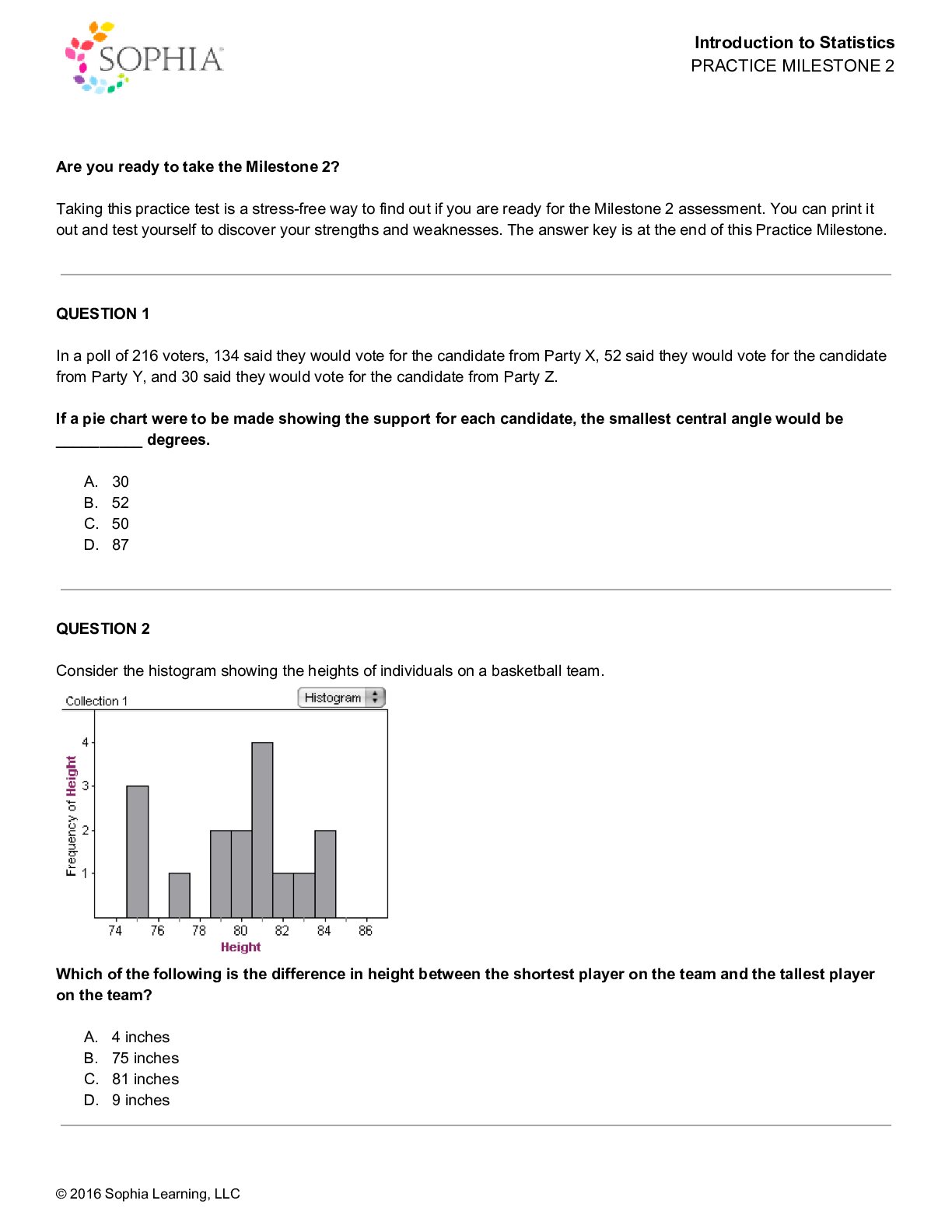
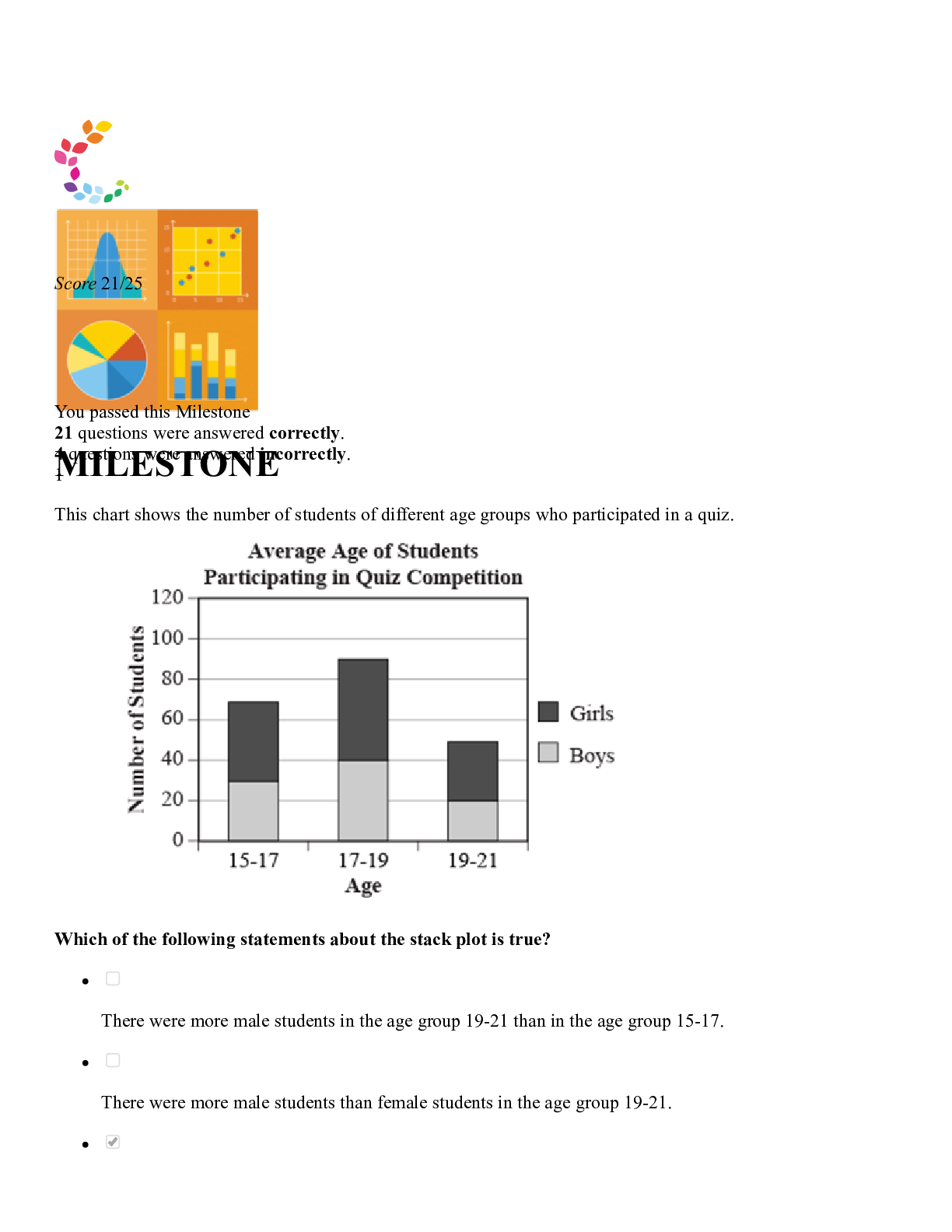


 – University of the People.png)

 – University of Maryland.png)
 – University of the People.png)
 – University of the People.png)
 – University of the People.png)




